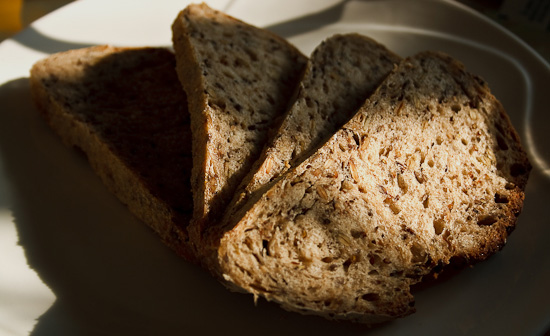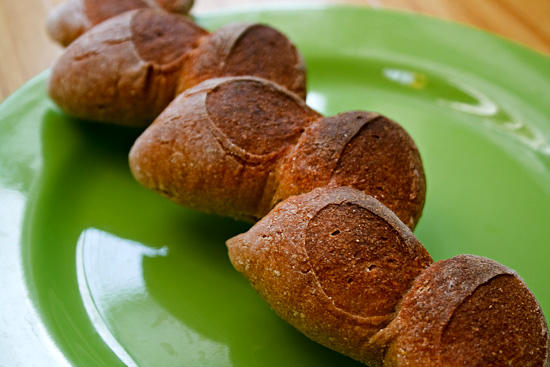Baking Bread in China: A Flour Glossary
While China may not have many “western” flours like durum or spelt, there are all kinds of flours unique to Asia here, like multiple varieties of millet, sorghum, and bean flours. You can also find flours like rye, barley, and buckwheat in special grain shops.
Note: Flour in Chinese can be referred to as either fen (粉) or mian (面). For most flours below, either fen or mian can be used interchangeably as the last character.
Basic Types of Wheat Flours
Other Wheat Flours
Non-Wheat Flours
Basic Wheat Flour Classification in China
A quick word about kernels of wheat, the basic unit out from which flour is ground:
The bran (麸皮 fupi) is the outer shell of the kernel, containing most of the fiber and vitamin B, but it is generally discarded from white flour. The germ (胚芽 peiya) is the germinating seed, containing vitamins, proteins, and healthy fats. The endosperm (胚乳 peiru) stores food – starch – for the germinating seed. It makes up 85% of the wheat kernel and is the main component of flour.
“Regular flour” – 普通粉 (putong fen)
This is a relatively unprocessed flour, retaining more of the bran and the germ. As a result, it is low in gluten but high in vitamins, fiber, and ash. Due to the coarseness of its milling, it sits low on the totem pole of flours, and is not even that easy to find in grocery stores in Beijing.
“Standard flour” 标准粉 (biaozhun fen)
More refined than regular flour, standard flour has had more of the bran removed. It is finer in texture, whiter, and has more gluten, but is lower in fiber. As you can imagine from the name, it’s widely available, and a good equivalent to all-purpose flour.
“Enriched flour” 富强粉 (fuqiang fen)
Traditionally highly valued for its refinement, enriched flour has declined slightly in popularity with growing attention on healthful whole grains. The bran and the germ have been completely removed, leaving only the endosperm. It is high in gluten, pure in flavor, and may be fortified with vitamins. Also called “special flour” 特制粉 (tezhi fen), “refined white flour” 精白粉 (jingbai fen), or refined flour 精制粉 (jingzhi fen).
Whole wheat flour 全麦粉 (quanmai fen)
Whole wheat flour is ground with the “whole” kernel – endosperm, germ and bran. However, whole wheat flours I’ve bought here in China seem less “whole”. The color is not as dark, and I suspect that some of the bran seems to have been removed to give it a more pleasing flavor and texture. I would guess it’s more similar to a T90 or a T110 French flour than King Arthur whole wheat flour.
Low-gluten flour 低筋粉 (dijin fen)
8.5% of gluten or less
Mid-gluten flour 中筋粉 (zhongjin fen)
Contains 8.5-11.5% gluten. Sold as standard flour.
High-gluten flour 高筋粉 (gaojin fen)
Contains 11.5-13.5% gluten
Other classifications of wheat flours
Bread flour 面包粉 (mianbao fen)
Contains around 13.5-14% gluten
Cake flour 蛋糕粉 (dangao fen)
Low in gluten
Cheng Fen 澄粉 (cheng fen)
Wheat flour from which the gluten has been completely removed. It is essentially wheat starch, and is used in making sticky rice cakes and mochi for that distinctive chewy, glutinous quality.
Dumpling flour 饺子粉 (jiaozi fen)
A relatively high gluten flour (around 11%). If you can’t find bread flour or high-gluten flour, dumpling flour is a good substitute as it is commonly sold in many supermarkets (in fact, it is really about the only flour I’ve seen carried everywhere)
Self-rising flour 自发粉 (zifa fen)
A mid-gluten, all-purpose flour mixed with baking soda (sodium bicarbonate), and an acidic salt, sometimes monocalcium phosphate (which is found in baking powder as well).
“Snowflake flour” 雪花粉 (xuehua fen)
A high-quality, high-gluten flour milled from the endosperm. The name suggests that its milling is as fine as snow. This can be used for bread-baking.
“Wheat heart flour” 麦心粉 (maixin fen)
Milled from the endosperm of the wheat kernel.
Youtiao flour 油条粉 (youtiao fen)
This flour contains several chemical additives needed to create the porous, chewy, spongy texture of youtiao, deep-fried dough crullers. I haven’t tried this flour, and don’t really intend to, either.
Other Flours
Rye flour 黑麦粉 (heimai fen)
Barley flour 大麦粉 / 青稞粉 (damai fen or qingke fen)
Buckwheat flour 荞麦粉 (qiaomai fen)
Naked oat flour 莜麦粉 (youmai fen)
Flour ground from youmai (莜麦), a hull-less member of the oat family native to central and western China. Many types of noodles in Shaanxi, Ningxia, Gansu, and Inner Mongolia are made with this flour.
Oat flour 燕麦粉 (yanmai fen)
Rice flour 米粉 (mi fen)
This is an excellent dusting flour to prevent bread dough from sticking to surfaces
Sticky rice / glutinous rice flour 江米粉 / 糯米粉 (jiangmi fen/nuomi fen)
Can be used to make rice cakes, niangao 年糕,yuanxiao 元宵, tangyuan 汤圆, mochi, etc.
Black rice flour 黑米粉 (heimi fen)
Corn flour 玉米面 (yumi mian)
Corn grits / polenta 玉米渣 (yumi zha)
Sorghum flour 高粱粉 (gaoliang fen)
Millet flour 小米粉 (xiaomi fen)
I frequently substitute up to a quarter of white flour in cakes with millet flour. Millet is actually a seed, thought to be cultivated in China earlier even than rice, with lots of healthy vitamins, minerals, fiber, and proteins.
Sweet potato flour 红薯粉 (hongshu fen)
Soybean flour 黄豆粉 (huangdou fen)
Mung bean flour 绿豆粉 (lüdou fen)




































